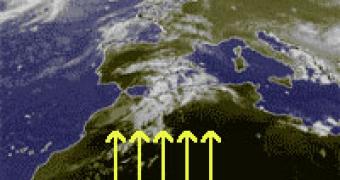Your friends have told you a lot about their holidays in sunny Spain. What could you want more: sun, warm weather, booze and sexy girls.
But when you get there, you may have the surprise of seeing snowed palms in Barcelona and wonder where did you leave the Eskimo suit. You have arrived in the middle of the "La Gota Fr?a" ("Cold Drop"), a common meteorological phenomenon in Spain. The most famous is that of 1982 which produced powerful floods in Valencia.
The Cold Drop is associated with extremely violent downpours and storms, with speeds of 100-200 km (60-120 mi)/hour, but not always accompanied by significant rainfall. For this it is necessary that the high atmospheric instability in the lower air layers to combine with a significant water vapors amount. In this combination, the masses of cold air can discharge rapidly 500 liter per square meter in extremely rapid rain episodes. This phenomenon usually lasts very little, as it exhausts its water reserves without receiving new supply. The clouds are formed over the Atlantic Ocean. The more extreme the temperatures, more water is stored in the clouds. Sometimes, the Cold Drop produces snow or hail.
The devastating effects of the Cold Drop induce powerful floods in the touristic Spanish Mediterranean coast but also the Basque Country, but the cold affects also central Spain. The phenomenon is more common during October (especially to the end) but also in April and February.
The Cold Drop appears when a front of very cold polar air, called jet stream, advances slowly over Western Europe, at high altitude (normally 5-9 km or 3-5.5 mi). If a sudden cut off in the stream takes place, caused by various motifs, like the effect of the high pressures, a bag of cold air detaches from the main jet stream, penetrating to the south over the Pyrenees Mountains into the Spain's warm air.
This way a great mass of cold air rotates and floats like a drop over a warm area.
The Cold Drop can cause floods over the dry beds of the ancient rivers and torrents. Houses built there can be devastated. If the terrain has no vegetation and there are high slopes and ravines, the water is not absorbed and it can destroy everything in its way. Under some circumstances (like air temperature, winds, humidity, and so on), the Cold Drop can be accelerated.
The instability of the atmosphere drags the warm air to the higher layers, while the cold air from above descends very quickly, being heavier than the warm one. The movements are ascendant in the anterior part of the drop, generating bad weather, and descendant in the rear part, generating good weather.

 14 DAY TRIAL //
14 DAY TRIAL //